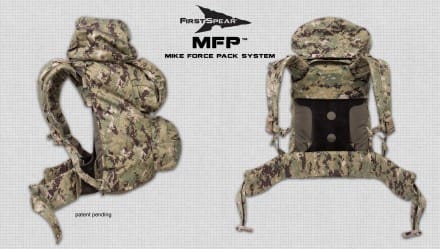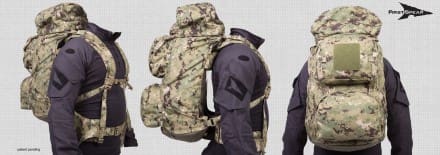It’s rare that I receive photos of a new product and say, “Wow, that is not what I expected,” but this week’s Friday focus evoked exactly that reaction. While FS has a distinct design aesthetic, I didn’t have something like this in my mind’s eye when they told me they had designed a jungle rucksack and frame. It’s also refreshing to see a product released before the season it’s meant for. There are are a variety of reasons to blame, but all too often we see mittens announced in Spring and shorts released in time for Thanksgiving.
But I digress. Please allow me to introduce the FS MIKE Force Pack System.
Paying respect to the vaunted Jungle Fighters who support US Special Forces in some of the most inhospitable tropical terrain on the planet the Mike Force Pack (MFP) utilizes many hard learned design features and augments them with modern, proven material advancements. The initial release scheduled for Summer 2015 will lead with the MFP, Standard – a 3.9-Pound Rucksack (Frame, Suspension and Pack included) with a cumulative volume of 2500 Cubic Inches. Utilizing advanced construction and fabric technology as well as innovative approaches in rapid drainage this design keeps close to its tropical combat roots while taking advantage of modern material advances. Optimized for loads in the 60-Pound range certain features in this system will ensure that when required, excessive loads can be managed.
Currently, there are three different sized waist belts planned for the MFP Suspension System and swapping out between them is easy and Operator friendly. The MIKE frame is one size fits most, and manufactured from an advanced thermal molded composition. For personnel not immediately familiar with pack systems designed for operations in deeply foliated, hot tropical environments the frame may initially seem to ride high, there is ample adjustment to raise and lower it on the body however, the design intent is to minimize conflict with your load bearing/fighting load, accentuate stand off from the back of the body to aid in ventilation/cooling and facilitate getting in and out of different body positions required for Jungle Warfare.
The MIKE Force Pack features two external pockets positioned on the outside, back center to aid in organization and provide access to smaller immediately needed items. An overstuff skirt is manufactured of lightweight/compressible material that is highly water resistant. The top flap of the pack is completely removable and features an accessory strap letting you use it as a Bolt Bag. An internal radio pocket can securely hold the AN/PRC-117G or dense, heavier items that are desired to be transported high and close to the back. Upcoming accessories will secure on to the MIKE Force Pack Standard and let you attach pockets and other features more suitable to open terrain, that will increase capacity further without changing to a larger bag. 2 Sleeves on the inner, side walls of the pack will each hold a 3 Liter On The Move drinking bladder and are aligned with pass through ports that allow the drinking hose to be accessed without having to open the pack. These same ports can be used for communication wires or antennas.
Additional bags, accessories and frame sizes/features as well as integrated floatation capabilities are planned for the MIKE Force Pack and will be phased into the FirstSpear product line. T&E systems are now available to agencies requesting a demonstration, contact FirstSpear for more details.
Tags: FirstSpear




Interesting. And it’s backwards compatible with the ALICE frame, which means a NICE frame could pair against it…
I wasn’t a fan of the Hotel23 pack, but this could be a winner. What’s the projected price point?
Not sure where you got that it’s compatible with the ALICE frame. While I’m sure you could come up with some way to rig it, the top of the pack is too narrow to accommodate the ALICE frame.
Without dimensions, it certainly looks like it could have fit an ALICE frame, hence my comment.
What are the dimensions?
I like the way it sits, the back ventilation is nice indeed!
Agreed, I like the external frame, the fact that the top flap is not part of the main compartment.
Changes from seeing pics: PALS at least on lower portion of sides for external canteens, machete, knives, smoke grenades, claymores etc… stuff that is used routinely during patrolling, during evac drills, or during conduct of a Break Contact battle drill.
Jon, OPT
I agree, the lower part needs a couple rows of PALS, if only for tie-downs.
I’d like to have one. Looks great both FS shirts and pack.
First question with any rucksack:
If I have to immediately go prone and return fire wearing this will the top of the ruck impede my ability to obtain a sight picture?
Most of the current rucks issued to SOF fail that test. One of the merits of the ALICE is it passes that test.
this is a nice ruck, great design, just need some hands on and rolling around in the dirt doing battle drills with it.
Jon, OPT
Even with the ALICE we were taught to drop the pack and fire from behind it.
That’s prefered, but not always SOP, espcecially during some battle drills. I’m not here to talk battle drills, I discussing equipment capabilities, and more importantly individual capabilities while wearing equipment.
Jon, OPT
Interesting, all the the current rucks in the SOF SPEAR program passed prone shooting drills, prior to rolling out of it. As always, there is a difference between intended (trained via NET) and applied use in the field that may preclude ideal head space.
so does that mean that to preserve pack volume, a pack that expands towards horizontally is preferred? (i.e. MR Mountain ruck)?
I’ll start with this, preference is subjective, and I can be picky about gear if need be; to me at the basic fill volume I prefer a pack not have anything to where I can’t lay in the prone and look forward, preferably obtain a sight picture as well (helmets make this almost impossible with most packs).
How it expands? Horizontal only works to a point before balance is really disrupted. Vertical towards ground can be a total pain in the ass (sometimes literally) and interfere with walking or need be running, Vertical upward, that may require changing of some SOPs (kneel instead of prone etc).
Like anything else, your equipment will most likely never reach a 100% solution for everything, get as close to 80% or higher if possible and adjust the extra 20% or less with training.
For a pack used in greenside opns I prefer being able to tilt my head back and look up, be able to go prone in said pack and engage, or simply be able to look over my shoulder and see behind me. These points are almost always the most overlooked portion of design, and a lot has to do with how load distribution is supposed to be with the human male body. Pack builders like MR, Kifaru, etc make great packs for long range movement, but not necessarily for patrolling. MR’s smaller pack issued to SOF is a good patrolling design as is Kifaru’s Zulu, though they create some interference, but nothing more than the average ALICE, it is nothing you can’t muscle through with some training under load.
What is the right answer? there really isn’t one, the human body wasn’t built to carry a ruck and shoot a rifle while laying down, but there is a line between possibility and impossibility with it.
Jon, OPT
Jon,
+1 Good points and well said.
Some aggressive load management and load discipline also helps keep the pack from becoming too cumbersome or extending too far out from the body in any dimension. Especially directly behind the head as you point out
TLB
Really like that stand off from the back.
While I really appreciate the historical significance of the name, another pack company is currently using this name. Not throwing stones, just pointing out that it could get confused. (Yes, I realize this is/will be a complete system and the other is only a pack).
…except that other pack company has taken its “Marauder” pack out of production…
Lots of packs have been called Marauders.
Is there an industry trend away from PALS? I’m so used to every pack being covered in webbing that it makes it look like a civi hiking pack without it.
The sides of this pack could use it, for previously stated reasons I put up on this post, personally I don’t see a need to add it to the already existing pouches.
Jon, OPT
God, I hope so. PALS should be place strategically, not over every square inch possible. My little Eagle assault pack is absolutely covered in PALS and I’ve only ever used about 10% of it, mainly to slap on an extra IFAK.
I’m either seeing loops for frame bars on the sides or a possible upgrade with tube fasteners on the side mounted to pouches like a dock ‘n lock.
Not super enthused about a D ring being the anchor point for the shoulder strap, the breaking strain isn’t high enough on that fitting for intended use and it’s essentially redundant, a fixed fin with the lower adjustment webbing anchored into the seam at a wider point to the strap to spread the load maybe an old fashioned way of doing it but it’s also proven.
jumpable?
Anything is jump able. You’ve just got to put it in a bag.